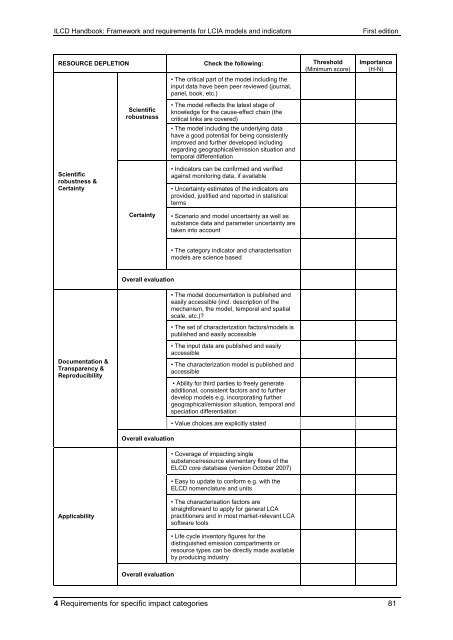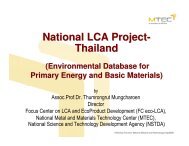ILCD Handbook: Framework and requirements for LCIA models and ...
ILCD Handbook: Framework and requirements for LCIA models and ...
ILCD Handbook: Framework and requirements for LCIA models and ...
You also want an ePaper? Increase the reach of your titles
YUMPU automatically turns print PDFs into web optimized ePapers that Google loves.
<strong>ILCD</strong> <strong>H<strong>and</strong>book</strong>: <strong>Framework</strong> <strong>and</strong> <strong>requirements</strong> <strong>for</strong> <strong>LCIA</strong> <strong>models</strong> <strong>and</strong> indicators First edition<br />
RESOURCE DEPLETION Check the following: Threshold<br />
(Minimum score)<br />
Scientific<br />
robustness &<br />
Certainty<br />
Documentation &<br />
Transparency &<br />
Reproducibility<br />
Applicability<br />
Scientific<br />
robustness<br />
Certainty<br />
Overall evaluation<br />
Overall evaluation<br />
Overall evaluation<br />
• The critical part of the model including the<br />
input data have been peer reviewed (journal,<br />
panel, book, etc.)<br />
• The model reflects the latest stage of<br />
knowledge <strong>for</strong> the cause-effect chain (the<br />
critical links are covered)<br />
• The model including the underlying data<br />
have a good potential <strong>for</strong> being consistently<br />
improved <strong>and</strong> further developed including<br />
regarding geographical/emission situation <strong>and</strong><br />
temporal differentiation<br />
• Indicators can be confirmed <strong>and</strong> verified<br />
against monitoring data, if available<br />
• Uncertainty estimates of the indicators are<br />
provided, justified <strong>and</strong> reported in statistical<br />
terms<br />
• Scenario <strong>and</strong> model uncertainty as well as<br />
substance data <strong>and</strong> parameter uncertainty are<br />
taken into account<br />
• The category indicator <strong>and</strong> characterisation<br />
<strong>models</strong> are science based<br />
• The model documentation is published <strong>and</strong><br />
easily accessible (incl. description of the<br />
mechanism, the model, temporal <strong>and</strong> spatial<br />
scale, etc.)?<br />
• The set of characterization factors/<strong>models</strong> is<br />
published <strong>and</strong> easily accessible<br />
• The input data are published <strong>and</strong> easily<br />
accessible<br />
• The characterization model is published <strong>and</strong><br />
accessible<br />
• Ability <strong>for</strong> third parties to freely generate<br />
additional, consistent factors <strong>and</strong> to further<br />
develop <strong>models</strong> e.g. incorporating further<br />
geographical/emission situation, temporal <strong>and</strong><br />
speciation differentiation<br />
• Value choices are explicitly stated<br />
• Coverage of impacting single<br />
substance/resource elementary flows of the<br />
ELCD core database (version October 2007)<br />
• Easy to update to con<strong>for</strong>m e.g. with the<br />
ELCD nomenclature <strong>and</strong> units<br />
• The characterisation factors are<br />
straight<strong>for</strong>ward to apply <strong>for</strong> general LCA<br />
practitioners <strong>and</strong> in most market-relevant LCA<br />
software tools<br />
• Life cycle inventory figures <strong>for</strong> the<br />
distinguished emission compartments or<br />
resource types can be directly made available<br />
by producing industry<br />
Importance<br />
(H-N)<br />
4 Requirements <strong>for</strong> specific impact categories 81



